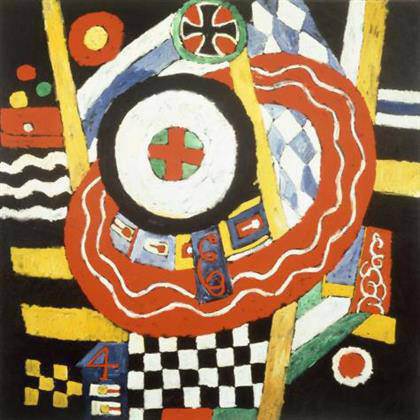
Marsden Hartley
The Iron Cross, 1915
Oil on canvas, 47 ¼ x 47 ¼ in. (120.02 x 120.02 cm)
Mildred Lane Kemper Art Museum, Washington University in St. Louis. University purchase, Bixby Fund, 1952
Marsden Hartley: German Paintings 1913–1915 – LACMA The Los Angeles County Museum of Art (LACMA) presents ‘Marsden Hartley: The German Paintings 1913–1915’ (August 3– November 30, 2014).]]>
Source: Los Angeles County Museum of Art
From 1912 to 1915, Hartley lived in Europe—firstin Paris and then in Berlin. There he developed a singular style that reflected his modernsurroundings and the tumultuous time before and during World War I. Berlin’s excitingurban environment, prominent gay community, and military spectacle had a profoundimpact upon him. “Marsden Hartley” features approximately 25 paintings from this criticalmoment in Hartley’s career that reveal dynamic shifts in style and subject matter comprisedof musical and spiritual abstractions, city portraits, and military symbols to Native Americanmotifs.
Throughout his career, Hartley moved between modes of abstraction and representationand experimented with portraiture, landscape, and symbolism. The paintings in theexhibition reveal the effects of the war and demonstrate his adoption of military symbolsand Native American motifs in two major series: the “War Motif” and “Amerika” paintings—characterized by the bold use of color and complex abstract compositions. In 1912,Hartley met Prussian officer Carl von Freyburg and soon developed a deep infatuation forhim. Von Freyburg was killed in the first few months of World War I, and Hartley’s sorrowover his death greatly affected the direction of his paintings, resulting in the War Motifseries. Hartley incorporated his interest in the German military and its regalia, often inreference to von Freyburg, into a coded approach to portraiture. For example, the IronCross, which von Freyburg was awarded, and the number four, his regiment number, oftenappear interwoven with boldly colored flags and monochrome backgrounds. Though theseries began as a memorial to his lost friend and love, over time the paintings transformedinto rich explorations of abstraction, color, and military motifs.
In his Amerika paintings, Hartley explores Native American imagery with geometricconfigurations of arrows, bows, and tipis comprising geometric compositions. During histime abroad, Hartley developed an admiration for Native American spirituality and visitedethnographic museums in Paris and Berlin to explore the art and traditions of thesepeoples. Hartley’s paintings reflect a long history in Germany of interest in Native Americancultures and aligned him with other German modernists such as the Blaue Reiter artistAugust Macke, who painted similar subject matter. Hartley’s Amerika series also revealsaffinities with the work of other modernist peers, including Pablo Picasso and GeorgesBraque, who explored in their work elements of what they considered “primitive” art. Inaddition, Hartley’s paintings expressed the growing contempt for the way the United Statesgovernment treated indigenous communities. His use of symmetrical geometriccompositions incorporated both abstraction and figuration with various Native Americanmotifs and vivid colors. Hartley’s other paintings from this period similarly combinerepresentational objects and abstract designs, resulting in vibrant studies of spirituality andmysticism.
Related content
German and French expressionism at the LACMA (exhibition, 2014)
Follow us on:


